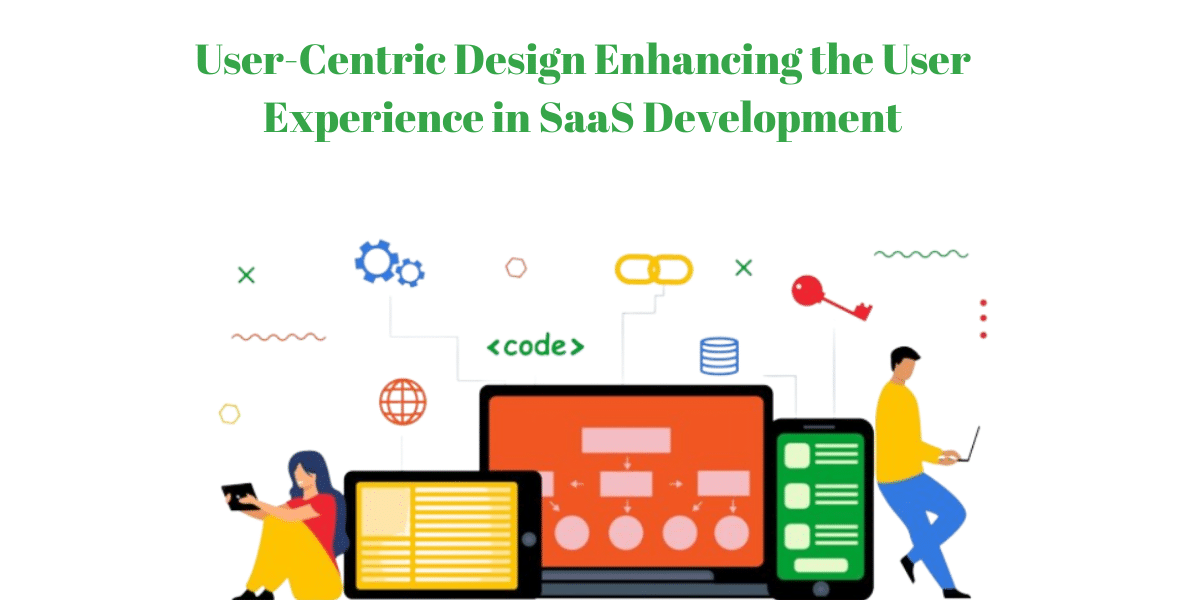In the realm of Software as a Service (SaaS), where the success of a product hinges on user adoption and satisfaction, prioritizing user experience (UX) is paramount. User-Centric Design stands as the cornerstone of crafting SaaS solutions that resonate deeply with users, fostering engagement, loyalty, and ultimately, business growth. This approach places users at the forefront of the design process, emphasizing empathy, understanding, and iterative improvement based on user feedback.
With an ever-growing array of SaaS offerings competing for attention, the differentiation often lies in the quality of the user experience. This introduction explores the pivotal role of User-Centric Design in enhancing the user experience within SaaS development.
By delving into principles, methodologies, and best practices, we aim to elucidate how SaaS providers can leverage user-centricity to create intuitive, efficient, and delightful experiences that not only meet but exceed user expectations, driving long-term success in a competitive market landscape.
Understanding the Importance of User Experience (UX) in SaaS
Understanding the Importance of User Experience (UX) in SaaS is critical for the success of any software product. In the realm of Software as a Service (SaaS), where applications are accessed remotely via the internet, the user experience plays a central role in driving adoption, retention, and overall satisfaction. A well-crafted UX can significantly impact user engagement, productivity, and loyalty, ultimately influencing the bottom line of SaaS providers.
Users today demand seamless, intuitive experiences that cater to their needs and preferences, and failure to meet these expectations can result in high churn rates and negative word-of-mouth. Furthermore, in an increasingly competitive market, where numerous alternatives exist for almost every SaaS solution, differentiation often boils down to the quality of the user experience. A positive UX can serve as a powerful differentiator, attracting new users and retaining existing ones, while a poor UX can drive users to seek alternatives. Moreover, a user-centric approach to design not only enhances the usability of the product but also fosters trust and credibility, as users feel valued and understood.
Consequently, investing in UX design is not just a matter of aesthetics but a strategic imperative for SaaS companies looking to thrive in today’s digital landscape. By prioritizing user experience, SaaS developers can create products that not only meet but exceed user expectations, driving sustainable growth and success in the competitive SaaS market.
Key Principles of User-Centric Design
User-Centric Design, the cornerstone of creating impactful and engaging experiences in software development, is guided by several key principles that prioritize the needs, behaviors, and preferences of users. Firstly, empathy stands as the foundation, requiring designers to deeply understand and empathize with the users they are designing for, gaining insights into their motivations, challenges, and goals.
Secondly, simplicity advocates for stripping away unnecessary complexity, focusing on clarity and intuitiveness to ensure users can accomplish tasks efficiently and without frustration. Thirdly, consistency across the user interface promotes familiarity and reduces cognitive load, fostering a seamless experience across different features and interactions. Fourthly, feedback loops facilitate continuous improvement, enabling designers to gather insights from user interactions and iterate on the design accordingly.
Additionally, flexibility acknowledges the diverse needs and preferences of users, allowing for customization and personalization to cater to individual requirements. Furthermore, accessibility ensures that the design is inclusive and usable by all, regardless of physical or cognitive abilities. Collaboration encourages interdisciplinary teamwork, involving stakeholders from various domains to contribute to the design process and ensure alignment with user needs and business objectives.
Ultimately, iteration emphasizes the iterative nature of design, recognizing that achieving optimal user experience is an ongoing journey of refinement and enhancement based on user feedback and evolving requirements. By adhering to these key principles, designers can create user-centric solutions that resonate deeply with users, driving satisfaction, engagement, and ultimately, business success.
Persona Development: Creating User Profiles for SaaS Products
Persona development is a crucial aspect of user-centric design, particularly in the context of creating SaaS products. Personas are fictional representations of target users that encapsulate their characteristics, behaviors, goals, and needs. By creating detailed user profiles, SaaS developers can gain deeper insights into their target audience, enabling them to design products that resonate with users on a more personal level. Persona development typically involves conducting thorough research, including user interviews, surveys, and data analysis, to identify common patterns and characteristics among target users.
These personas help SaaS teams to humanize their users, allowing them to empathize with their needs and challenges throughout the design process. Furthermore, personas serve as a reference point for decision-making, helping teams prioritize features, functionalities, and design elements that align with the needs and preferences of their target audience.
Additionally, personas facilitate effective communication within cross-functional teams, ensuring that everyone involved in the development process shares a clear understanding of who the users are and what they require from the product. By investing time and effort in persona development, SaaS developers can create products that are not only functional and efficient but also deeply resonant with their intended users, ultimately leading to higher user satisfaction, engagement, and retention.
Conducting User Research for SaaS Development
Conducting user research is an indispensable step in the development of Software as a Service (SaaS) products, ensuring that they are built to address the specific needs and preferences of their target audience effectively. User research involves a systematic approach to gathering insights into user behaviors, motivations, and pain points through various qualitative and quantitative methods.
Qualitative methods such as user interviews, contextual inquiries, and usability testing allow developers to gain a deep understanding of user needs and preferences by directly engaging with them in real-world contexts. On the other hand, quantitative methods such as surveys, analytics data analysis, and A/B testing provide valuable statistical insights into user behaviors and preferences at scale. By combining both qualitative and quantitative approaches, SaaS developers can obtain a comprehensive understanding of their users, uncovering valuable insights that inform design decisions and product improvements.
Moreover, user research helps validate assumptions, mitigate risks, and prioritize features based on user needs, ultimately leading to the creation of more user-centric and successful SaaS products. Additionally, ongoing user research throughout the product lifecycle ensures that SaaS developers stay attuned to evolving user needs and market trends, allowing them to continuously refine and enhance their products to maintain competitiveness and relevance. In essence, user research serves as the foundation for effective SaaS development, enabling developers to build products that not only meet but exceed user expectations, driving satisfaction, engagement, and long-term success.
Utilizing Design Thinking for SaaS UX Enhancement
Utilizing design thinking methodology can significantly enhance the user experience (UX) in the development of Software as a Service (SaaS) products. Design thinking is a human-centered approach to innovation that prioritizes empathy, collaboration, and iterative problem-solving. In the context of SaaS UX enhancement, design thinking involves a structured process that begins with empathizing with users to deeply understand their needs, challenges, and aspirations.
This often entails conducting user research, such as interviews, observations, and journey mapping, to gain insights into user behaviors and pain points. Subsequently, designers define the problem space by synthesizing research findings and identifying key opportunities for improvement. Ideation then follows, where cross-functional teams brainstorm creative solutions to address the identified challenges. Prototyping allows designers to quickly iterate and visualize potential solutions, which are then tested with users to gather feedback and refine the designs iteratively.
Through this iterative process of empathizing, defining, ideating, prototyping, and testing, design thinking enables SaaS developers to create solutions that are not only functional but also intuitive, efficient, and delightful for users. Moreover, design thinking fosters a collaborative culture within development teams, encouraging diverse perspectives and cross-disciplinary collaboration to generate innovative solutions. By embracing design thinking principles, SaaS developers can unlock new opportunities for UX enhancement, leading to more successful and user-centric products that meet the evolving needs of their target audience.
The Role of Prototyping in User-Centric SaaS Design
Prototyping plays a pivotal role in user-centric Software as a Service (SaaS) design, serving as a bridge between conceptualization and implementation while facilitating iterative refinement based on user feedback. In the context of SaaS development, where the user experience (UX) holds significant weight in product success, prototyping offers a tangible means to visualize and test design concepts before investing resources into full-scale development.
Prototypes range from low-fidelity sketches to high-fidelity interactive simulations, allowing designers to explore different design solutions and gather early feedback from stakeholders and end-users. By creating prototypes, SaaS developers can validate design assumptions, identify usability issues, and iteratively refine the user interface (UI) to ensure optimal usability and effectiveness. Moreover, prototypes enable designers to communicate design intent and functionality to cross-functional teams, fostering collaboration and alignment throughout the development process.
Additionally, prototyping facilitates rapid experimentation and iteration, accelerating the design process and reducing the risk of costly design flaws later in the development lifecycle. Furthermore, prototyping supports user testing, providing a platform for users to interact with the design in a simulated environment and provide valuable insights for refinement. By leveraging prototyping in user-centric SaaS design, developers can create products that not only meet but exceed user expectations, driving higher adoption rates, user satisfaction, and ultimately, business success.
Iterative Design Process: Enhancing SaaS Products Based on User Feedback
The iterative design process stands as a cornerstone in enhancing Software as a Service (SaaS) products based on user feedback, fostering continuous improvement and optimization. Rooted in the principles of user-centric design, this iterative approach revolves around a cycle of prototyping, testing, and refining, guided by insights gleaned from user feedback.
Initially, SaaS developers create prototypes or iterations of the product, ranging from low-fidelity wireframes to high-fidelity mock-ups, embodying various design solutions and functionalities. These prototypes are then subjected to rigorous user testing, where real users interact with the product and provide feedback on its usability, functionality, and overall user experience. The insights gathered from user testing are meticulously analyzed, identifying pain points, areas of confusion, and opportunities for enhancement. Based on this feedback, developers iteratively refine and iterate upon the design, implementing changes that address user concerns and align more closely with user needs and expectations.
This iterative cycle continues throughout the development lifecycle, with each iteration bringing the product closer to achieving optimal user experience. By embracing an iterative design process driven by user feedback, SaaS developers can create products that are not only functional but also intuitive, efficient, and delightful for users. Moreover, this approach fosters a culture of continuous improvement and innovation within development teams, ensuring that the product evolves dynamically to meet the evolving needs and preferences of its user base. Ultimately, the iterative design process enables SaaS products to stay relevant, competitive, and successful in an ever-changing market landscape.
Accessibility and Inclusivity in SaaS User Experience
Accessibility and inclusivity are integral components of user experience (UX) design in Software as a Service (SaaS), ensuring that products are usable by individuals of all abilities and backgrounds. Accessibility encompasses designing interfaces and features that can be accessed and used by people with disabilities, including visual, auditory, motor, and cognitive impairments. Inclusivity, on the other hand, extends beyond accessibility to encompass designing for diverse user demographics, including different age groups, cultural backgrounds, and language preferences.
By prioritizing accessibility and inclusivity in SaaS UX design, developers can create products that cater to a broader audience, foster a sense of belonging, and mitigate the risk of excluding marginalized or underserved user groups. This involves adhering to established accessibility standards and guidelines, such as the Web Content Accessibility Guidelines (WCAG), and incorporating inclusive design practices throughout the development process. Examples of inclusive design strategies include providing alternative text for images, offering customizable font sizes and color schemes, ensuring keyboard navigability, and supporting screen readers and other assistive technologies.
Additionally, conducting user testing with individuals from diverse backgrounds and abilities can uncover usability barriers and inform iterative improvements to enhance accessibility and inclusivity. By embracing accessibility and inclusivity in SaaS UX design, developers not only comply with legal requirements and ethical considerations but also unlock opportunities for innovation, differentiation, and market expansion. Moreover, creating products that are accessible and inclusive aligns with broader societal values of equity and social responsibility, driving positive impact and fostering goodwill among users and stakeholders.
Responsive Design: Optimizing SaaS for Various Devices and Screen Sizes
Responsive design is paramount in optimizing Software as a Service (SaaS) products for various devices and screen sizes, ensuring a seamless and consistent user experience across desktops, laptops, tablets, and smartphones. In an era where users access SaaS applications from a myriad of devices, responsive design enables products to adapt dynamically to different screen sizes, resolutions, and orientations.
This adaptability is achieved through the use of flexible layouts, fluid grids, and media queries that adjust content and design elements based on the device’s viewport dimensions. By embracing responsive design principles, SaaS developers can eliminate the need for separate desktop and mobile versions of their applications, streamlining development efforts and reducing maintenance overhead. Moreover, responsive design enhances accessibility and usability, allowing users to interact with SaaS products comfortably and efficiently regardless of the device they use. Key considerations in responsive design include optimizing touch interactions for mobile devices, prioritizing content hierarchy for smaller screens, and ensuring fast loading times across all devices.
Additionally, thorough testing across various devices and browsers is essential to identify and address any compatibility issues or design inconsistencies. By prioritizing responsive design in SaaS development, developers can deliver a superior user experience that adapts seamlessly to the diverse preferences and usage patterns of modern-day users, driving higher engagement, satisfaction, and retention. Ultimately, responsive design not only enhances the usability and accessibility of SaaS products but also future-proofs them against the ever-evolving landscape of digital devices and technologies.
Streamlining Onboarding Processes for New SaaS Users
Streamlining the onboarding process for new Software as a Service (SaaS) users is essential for facilitating seamless user adoption and maximizing retention rates. Effective onboarding sets the tone for the user’s entire experience with the SaaS product, influencing their perception of its value and usability. To streamline the onboarding process, developers must prioritize clarity, simplicity, and efficiency.
This begins with designing a user-friendly interface that guides new users through the initial setup process with intuitive prompts, clear instructions, and minimal friction. Offering guided tours, tooltips, and interactive tutorials can help users familiarize themselves with key features and functionalities quickly. Additionally, incorporating progressive disclosure techniques allows users to explore advanced features at their own pace, without overwhelming them during the initial onboarding phase. Personalization also plays a crucial role in onboarding, as tailoring the experience to the user’s specific needs and goals enhances relevance and engagement. Leveraging automation and data-driven insights, developers can deliver personalized onboarding experiences based on user behavior, preferences, and demographic information.
Moreover, providing access to comprehensive help resources, such as knowledge bases, FAQs, and customer support channels, empowers users to troubleshoot issues independently and accelerates their proficiency with the SaaS product. Continuously monitoring and analyzing user feedback and metrics allows developers to identify pain points in the onboarding process and implement iterative improvements to enhance user satisfaction and retention. By streamlining the onboarding process, SaaS developers can create a positive first impression, increase user confidence, and lay the foundation for long-term user engagement and loyalty.
Intuitive Navigation Design in SaaS Platforms
Intuitive navigation design is a cornerstone of user experience (UX) in Software as a Service (SaaS) platforms, ensuring that users can easily and efficiently navigate through the application to achieve their goals. Intuitive navigation design revolves around organizing information and functionality in a logical and predictable manner, minimizing cognitive load and enabling users to find what they need quickly and effortlessly.
Key principles of intuitive navigation design include simplicity, consistency, and hierarchy. Simplicity entails presenting users with a clean and uncluttered interface, free from unnecessary distractions or complexities. Consistency ensures that navigation elements, such as menus, buttons, and links, behave predictably across different sections of the SaaS platform, reducing confusion and enhancing usability. Hierarchy involves structuring content and features based on their importance and relevance, guiding users’ attention and actions towards the most essential elements first.
Additionally, employing familiar design patterns, such as dropdown menus, breadcrumb navigation, and clickable icons, aids in reducing the learning curve for new users and enhances overall usability. User testing and feedback play a crucial role in refining navigation design, allowing developers to identify pain points and optimize navigation pathways based on real-world usage scenarios. Moreover, leveraging analytics data and heatmaps provides valuable insights into user behavior and interaction patterns, informing iterative improvements to navigation design over time. By prioritizing intuitive navigation design in SaaS platforms, developers can enhance user satisfaction, increase productivity, and foster long-term engagement and loyalty, ultimately driving the success and competitiveness of their products in the market.
Visual Design and Branding in SaaS UX
Visual design and branding play a pivotal role in shaping the user experience (UX) of Software as a Service (SaaS) products, influencing users’ perceptions, emotions, and interactions with the platform.
Visual design encompasses the aesthetic elements of the user interface (UI), including color schemes, typography, imagery, and layout, which collectively contribute to the overall look and feel of the application. Consistent visual design establishes a strong brand identity, reinforcing brand recognition and trust among users. By aligning visual elements with the brand’s personality, values, and target audience, developers can evoke specific emotions and associations that resonate with users and differentiate the SaaS product from competitors. Moreover, visual hierarchy and information architecture guide users’ attention and navigation, directing them towards key features and content areas effectively.
Accessibility considerations, such as color contrast and text legibility, ensure that the visual design is inclusive and usable by all users, regardless of their abilities. Furthermore, user interface animations and micro-interactions add depth and interactivity to the user experience, delighting users and enhancing engagement.
Iterative design processes, including prototyping and user testing, allow developers to gather feedback on visual design elements and iterate on them to optimize usability and aesthetics. By prioritizing visual design and branding in SaaS UX, developers can create cohesive, memorable, and impactful experiences that not only meet user needs but also foster brand loyalty and advocacy, driving long-term success and competitive advantage in the market.
Optimizing Performance for Seamless User Experience
Optimizing performance is essential for delivering a seamless user experience (UX) in Software as a Service (SaaS) applications, as it directly impacts user satisfaction, engagement, and retention. Performance optimization involves enhancing the speed, responsiveness, and reliability of the SaaS platform across various devices and network conditions. One critical aspect of performance optimization is reducing loading times, ensuring that users can access and interact with the application swiftly.
This involves optimizing code, minimizing file sizes, and leveraging caching and content delivery networks (CDNs) to deliver content efficiently. Additionally, streamlining server-side processes and database queries can improve backend performance, reducing latency and ensuring smooth data retrieval and processing. Prioritizing asynchronous loading and lazy loading of resources allows critical content to be displayed quickly, while non-essential elements load in the background. Moreover, optimizing for mobile devices and low-bandwidth connections is crucial for accommodating users with diverse browsing environments.
Continuous monitoring and performance testing help identify bottlenecks and areas for improvement, enabling developers to iteratively refine and optimize the SaaS platform over time. Prioritizing performance optimization not only enhances user satisfaction and productivity but also positively impacts key metrics such as conversion rates and user retention. By delivering a fast, responsive, and reliable user experience, SaaS developers can differentiate their products in a competitive market landscape, driving user loyalty and long-term success.
Personalization Strategies for Tailored User Experiences
Personalization strategies are instrumental in creating tailored user experiences (UX) within Software as a Service (SaaS) applications, enhancing user engagement, satisfaction, and retention. Personalization involves dynamically adapting the content, features, and interactions of the SaaS platform to align with the preferences, behaviors, and needs of individual users.
One common personalization strategy is leveraging user data to deliver customized recommendations and content suggestions based on past interactions, preferences, and demographic information. By analyzing user behavior and engagement patterns, developers can identify opportunities for personalized recommendations, such as product suggestions, relevant articles, or tailored workflows.
Additionally, allowing users to customize their experience through preferences and settings empowers them to tailor the platform to their specific needs and preferences, enhancing user satisfaction and ownership. Furthermore, contextual personalization involves adapting the user experience based on situational factors such as location, device type, and time of day, ensuring relevance and timeliness of content and features. Integrating machine learning and artificial intelligence algorithms enables SaaS platforms to continuously learn from user interactions and refine personalization strategies over time, delivering increasingly relevant and impactful experiences.
However, it is essential to prioritize user privacy and data security when implementing personalization strategies, ensuring transparent data practices and providing users with control over their personal information. By embracing personalization strategies in SaaS UX design, developers can foster stronger connections with users, drive higher engagement and retention rates, and differentiate their products in a competitive market landscape.
Integrating Feedback Loops for Continuous Improvement
Integrating feedback loops for continuous improvement is a cornerstone of effective Software as a Service (SaaS) development, enabling developers to gather insights from users and iterate on their products iteratively. Feedback loops involve systematically collecting feedback from users at various touchpoints throughout the user journey and using that feedback to inform product enhancements and optimizations.
One key component of feedback loops is soliciting feedback proactively through surveys, in-app feedback forms, and user interviews, allowing developers to gather valuable insights into user needs, pain points, and preferences. Additionally, leveraging analytics tools and user behavior tracking enables developers to gain quantitative insights into user interactions and usage patterns, identifying areas for improvement and optimization. Feedback should be analyzed systematically, categorizing and prioritizing feedback based on its impact on user experience and business objectives. Moreover, transparency and responsiveness are essential in closing the feedback loop, ensuring that users feel heard and valued for their input.
Communicating updates and improvements based on user feedback fosters trust and engagement among users, encouraging ongoing participation in the feedback process. Furthermore, iterative development methodologies such as agile or lean facilitate rapid iteration and experimentation based on user feedback, allowing developers to implement and test improvements quickly. By embracing feedback loops for continuous improvement, SaaS developers can create products that are more user-centric, responsive, and aligned with user needs and expectations, ultimately driving higher user satisfaction, engagement, and retention rates in a competitive market landscape.
Data-Driven Decision Making in SaaS UX Design
Data-driven decision-making is a foundational approach in optimizing user experience (UX) design within Software as a Service (SaaS) platforms, enabling developers to leverage insights derived from user data to inform design decisions and optimizations. In the context of SaaS UX design, data-driven decision-making involves collecting, analyzing, and interpreting user data to understand user behaviors, preferences, and pain points.
This data can be sourced from various sources, including user interactions, engagement metrics, user feedback, and usability testing. By analyzing quantitative metrics such as user activity, conversion rates, and retention rates, developers can identify patterns and trends in user behavior, uncovering areas for improvement and optimization within the UX design. Additionally, qualitative data from user feedback and usability testing provides valuable insights into user perceptions, preferences, and pain points, offering deeper context and understanding to complement quantitative findings.
Data-driven decision-making enables developers to prioritize design enhancements and optimizations based on empirical evidence and user needs, mitigating the risk of subjective bias or assumptions. Moreover, continuous monitoring and analysis of user data facilitate iterative refinement and experimentation, allowing developers to test design changes and measure their impact on user experience metrics. By embracing data-driven decision-making in SaaS UX design, developers can create products that are more user-centric, effective, and aligned with user needs and expectations, ultimately driving higher user satisfaction, engagement, and retention rates in a competitive market landscape.
Balancing Functionality with Simplicity in SaaS Interfaces
Balancing functionality with simplicity is a critical aspect of designing effective Software as a Service (SaaS) interfaces, ensuring that users can efficiently accomplish tasks while maintaining a streamlined and intuitive user experience. Striking this balance requires careful consideration of both the breadth of features offered and the clarity and ease of use of the interface.
While it may be tempting to incorporate a multitude of features to cater to diverse user needs, an overly complex interface can overwhelm users and hinder usability. Instead, developers should prioritize essential features that align with user goals and workflows, avoiding unnecessary clutter and complexity. This involves conducting thorough user research to understand user needs, preferences, and pain points, allowing developers to prioritize features that add genuine value to the user experience. Additionally, employing principles of information architecture and visual hierarchy helps organize content and features in a logical and intuitive manner, guiding users’ attention and actions effectively.
Simplicity in SaaS interfaces entails clear and concise language, intuitive navigation, and minimalist design elements, reducing cognitive load and friction in user interactions. However, simplicity should not come at the expense of functionality; instead, developers should strive to strike a delicate balance between providing robust functionality and maintaining a clean and intuitive interface.
Iterative testing and feedback loops enable developers to refine the interface iteratively, identifying opportunities to streamline workflows, simplify interactions, and optimize usability. By prioritizing a balanced approach to functionality and simplicity in SaaS interfaces, developers can create products that are both powerful and user-friendly, driving higher user satisfaction, engagement, and retention rates.
Enhancing User Engagement through Gamification
Enhancing user engagement through gamification has emerged as a powerful strategy in Software as a Service (SaaS) platforms, leveraging game-like elements and mechanics to motivate and incentivize user interactions. Gamification involves integrating elements such as points, badges, levels, challenges, and leaderboards into the user experience, transforming mundane tasks into enjoyable and rewarding experiences.
By tapping into fundamental human desires for achievement, competition, and social interaction, gamification fosters deeper engagement and sustained usage of SaaS platforms. Points and badges are awarded to users for completing tasks or reaching milestones, providing tangible rewards and recognition for their efforts. Progression systems, such as levelling up or unlocking new features, offer a sense of accomplishment and advancement, motivating users to continue engaging with the platform. Challenges and quests introduce elements of competition and achievement, encouraging users to push their limits and strive for mastery. Additionally, leaderboards foster a sense of social comparison and community, allowing users to see how they stack up against their peers and fostering healthy competition. However, effective gamification requires careful design and integration, ensuring that game-like elements are aligned with user goals and contribute to the overall user experience.
Moreover, personalization and customization play a crucial role in tailoring gamification mechanics to individual preferences and behaviors, enhancing relevance and engagement. By leveraging gamification in SaaS platforms, developers can create immersive, enjoyable, and rewarding experiences that drive higher user engagement, retention, and loyalty, ultimately contributing to the success and competitiveness of their products in the market.
Addressing User Pain Points in SaaS Design
Addressing user pain points in SaaS design is essential for creating products that meet the needs and expectations of users, ultimately leading to higher satisfaction, retention, and loyalty. User pain points refer to the specific challenges, frustrations, or obstacles that users encounter while using a SaaS platform, which can hinder their productivity and overall experience.
Identifying and addressing these pain points requires a deep understanding of user needs, preferences, and behaviors, often gained through user research methods such as surveys, interviews, and usability testing. Once pain points are identified, developers can prioritize solutions that alleviate these issues and enhance the user experience. This may involve simplifying complex workflows, streamlining navigation, improving performance and responsiveness, or providing better access to support and resources. Additionally, proactive communication and transparency about ongoing improvements and resolutions demonstrate a commitment to addressing user concerns and fostering trust.
Iterative design and development processes allow for continuous refinement and optimization based on user feedback, ensuring that pain points are continuously identified and addressed throughout the product lifecycle. By effectively addressing user pain points in SaaS design, developers can create products that not only meet user needs but also exceed expectations, driving higher user satisfaction, engagement, and long-term success in the competitive SaaS market landscape.
Cross-Platform Consistency in SaaS Applications
Cross-platform consistency in SaaS applications is crucial for ensuring a seamless and cohesive user experience across different devices and operating systems, ultimately enhancing usability, accessibility, and user satisfaction. With users accessing SaaS applications from various devices such as desktops, laptops, tablets, and smartphones, maintaining consistency in design, functionality, and performance is paramount.
This consistency starts with a unified design language and visual identity, ensuring that interface elements, typography, color schemes, and branding remain consistent across all platforms. Additionally, consistent navigation patterns and interaction behaviors help users navigate the application intuitively, regardless of the device they are using. Ensuring feature parity across platforms is also essential, ensuring that users have access to the same set of functionalities and capabilities regardless of the device they choose.
Moreover, optimizing performance and responsiveness for different screen sizes and resolutions ensures that the application functions smoothly and efficiently on any device. Cross-platform consistency also extends to data synchronization and continuity of user experience, allowing users to seamlessly transition between devices without losing their progress or data. Achieving cross-platform consistency requires close collaboration between design, development, and quality assurance teams, as well as adherence to established design guidelines and best practices. Regular testing across multiple devices and platforms helps identify and address any inconsistencies or compatibility issues, ensuring a uniform and optimal user experience across the entire ecosystem of SaaS applications. By prioritizing cross-platform consistency, SaaS developers can create products that are more accessible, user-friendly, and adaptable to users’ diverse needs and preferences, ultimately driving higher user satisfaction and engagement.
Security and Privacy Considerations in User-Centric SaaS Design
Security and privacy considerations are paramount in user-centric Software as a Service (SaaS) design, ensuring the protection of sensitive user data and fostering trust among users. User-centric SaaS design involves prioritizing the needs, preferences, and safety of users throughout the development process. One key aspect of this is implementing robust security measures to safeguard user data against unauthorized access, breaches, and cyber threats. This includes encryption protocols, access controls, authentication mechanisms, and regular security audits to identify and address vulnerabilities.
Additionally, privacy-by-design principles should be integrated into the design process, ensuring that user data is collected, stored, and processed in compliance with relevant regulations and industry standards, such as the General Data Protection Regulation (GDPR) and the California Consumer Privacy Act (CCPA). Providing transparent information about data handling practices, obtaining explicit consent for data processing, and offering users control over their data through privacy settings and preferences further enhances privacy protection.
Moreover, incorporating privacy-enhancing technologies such as anonymization and pseudonymization helps minimize the risk of data exposure while still enabling personalized user experiences. Security and privacy considerations should be integrated into every stage of the SaaS development lifecycle, from initial design and development to deployment, maintenance, and beyond. By prioritizing security and privacy in user-centric SaaS design, developers can build trust with users, mitigate regulatory risks, and differentiate their products in a competitive market landscape, ultimately driving higher user adoption, satisfaction, and loyalty.
A/B Testing and Experimentation for UX Optimization
A/B testing and experimentation are powerful tools for optimizing user experience (UX) in Software as a Service (SaaS) applications, enabling developers to make data-driven decisions and continuously improve the usability and effectiveness of their products. A/B testing involves comparing two or more variations of a design or feature to determine which one performs better in terms of predefined metrics, such as conversion rates, engagement, or retention.
By randomly assigning users to different variations and measuring their interactions and outcomes, developers can identify the most effective design elements, layout configurations, or feature implementations. This iterative approach allows for incremental improvements to be made over time, refining the UX based on empirical evidence and user feedback. Experimentation goes beyond traditional A/B testing by allowing developers to explore new ideas and hypotheses in a controlled environment. This may involve testing entirely new features, workflows, or design concepts to assess their impact on user behavior and satisfaction. By embracing experimentation, developers can foster innovation and creativity while minimizing the risk of negative user reactions.
Additionally, integrating A/B testing and experimentation into the development process fosters a culture of continuous improvement and learning, empowering teams to iterate rapidly and adapt to changing user needs and market dynamics. However, it is essential to approach A/B testing and experimentation with careful planning and analysis, ensuring that experiments are well-defined, hypotheses are clear, and results are interpreted accurately. By leveraging A/B testing and experimentation for UX optimization, SaaS developers can create products that are more user-centric, effective, and competitive in the ever-evolving digital landscape.
Collaborative Design Approaches in SaaS Development Teams
Collaborative design approaches are integral to successful Software as a Service development teams, fostering creativity, innovation, and alignment among team members with diverse expertise and perspectives. In collaborative design, team members from various disciplines, including designers, developers, product managers, and stakeholders, work together closely throughout the design process, from ideation to implementation and iteration.
This collaborative approach encourages cross-functional communication and cooperation, enabling teams to leverage collective knowledge and skills to tackle complex design challenges effectively. Techniques such as design thinking workshops, brainstorming sessions, and co-design activities facilitate idea generation and exploration, allowing team members to contribute insights and solutions collaboratively. Additionally, tools and platforms for collaborative design, such as shared design documents, prototyping tools, and version control systems, promote transparency, versioning, and real-time collaboration, streamlining the design process and ensuring alignment among team members.
Moreover, involving stakeholders and end-users in the design process through participatory design activities, user feedback sessions, and usability testing fosters a sense of ownership and empathy, leading to more user-centric and impactful design solutions. By embracing collaborative design approaches, SaaS development teams can break down silos, accelerate decision-making, and drive innovation, ultimately delivering products that meet user needs, exceed expectations, and maintain a competitive edge in the market.
The Key Takeaway
In conclusion, SaaS development is a multifaceted endeavor that demands a holistic approach to user experience (UX) design. Throughout this discussion, we’ve explored various strategies and methodologies aimed at enhancing the usability, accessibility, and effectiveness of SaaS applications.
From user-centric design principles to data-driven decision-making, from cross-platform consistency to collaborative design approaches, each aspect contributes to creating products that not only meet but exceed user expectations. By prioritizing user needs, integrating feedback loops, and leveraging innovative techniques such as gamification and experimentation, SaaS developers can drive higher user engagement, satisfaction, and loyalty.
Moreover, by addressing security, privacy, and performance considerations, developers can build trust with users and differentiate their products in a competitive market landscape. Ultimately, by embracing these principles and practices, SaaS development teams can deliver impactful, user-centric solutions that drive business success and create meaningful experiences for users around the globe.











